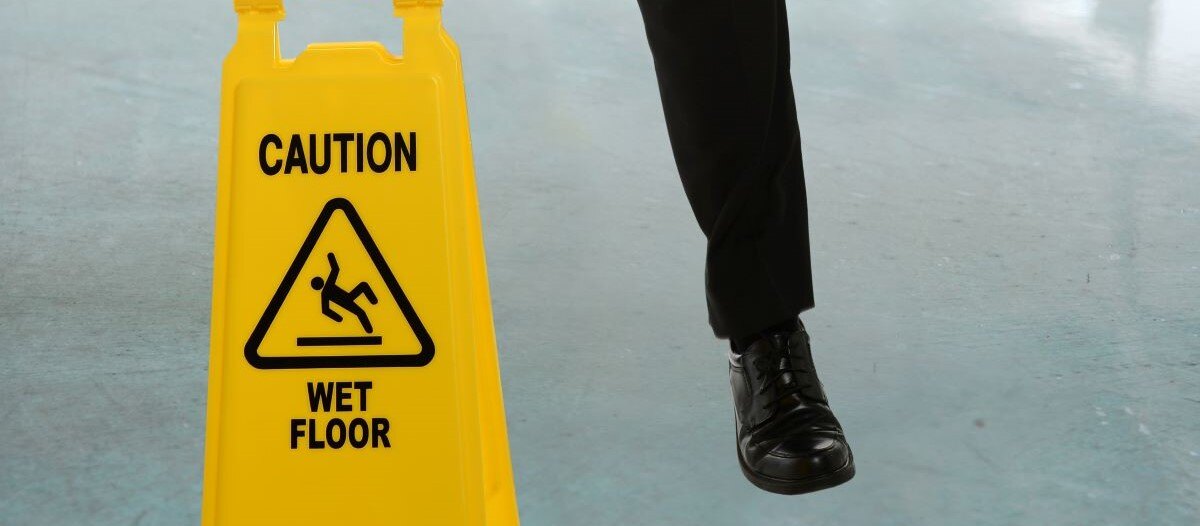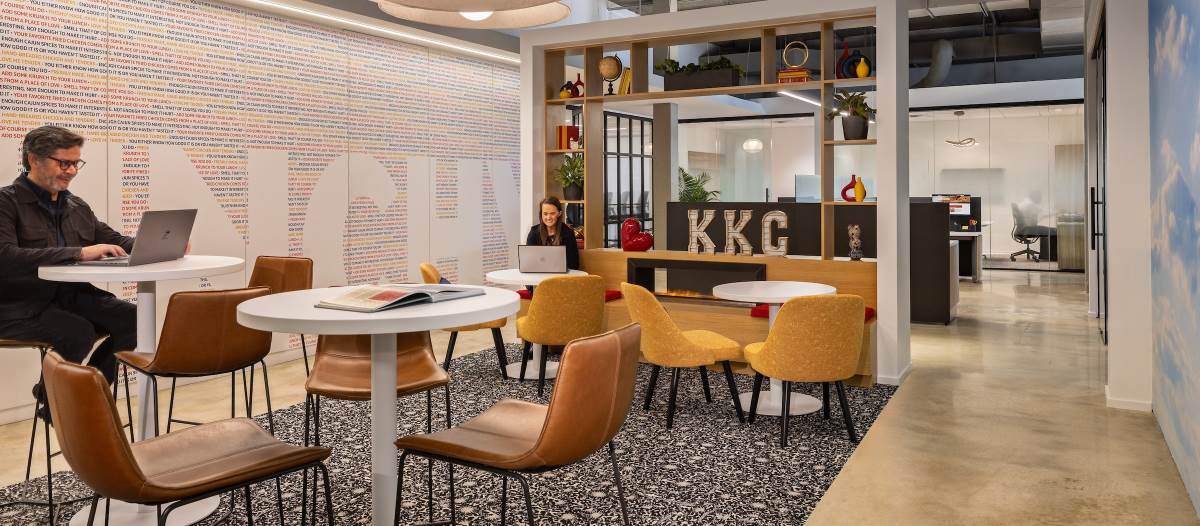Proactive Strategies
Preventing slips & falls

Slips and falls are like a secret tax that everyone must pay. For the people who experience the accident, falls can mean time away from work, reduced income, pain, inconvenience and long-term disability. Accidents can impact companies too – from employee morale and productivity to brand reputation. This is in addition to hard costs like medical expenses, increased insurance premiums and potentially costly litigation. These accidents can also sap staff morale and hamper guests’ confidence. No one entering a business should have to wonder if they are safe.
Slips and falls have long been a serious problem and the dangers continue to increase. According to the Consumer Product Safety Commission, inappropriate flooring contributes to 2 million falls. In 2021, work-related deaths from slips and falls increased 5.6 percent. According to a 2021 Liberty Mutual Insurance Survey, falls on the same level were the second leading cause of injury, costing more than $10.5 billion. Falls to a lower level were the third leading cause of injury, costing $6.2 billion.
Part of the problem is old-fashioned denial and complacency. Company leadership may believe slips and falls are problems for other facilities, not theirs. That may be true for a while, but eventually, a risky environment will likely cause an accident. At that point, companies must respond reactively.
It is also important for leaders to recognize that going months without an accident only implies a facility is safe. To ensure safety, facility managers and others must assess actual risks and develop solutions that measurably lower them. Taking proactive measures is the only way to truly reduce obvious slip-and-fall risks to people, property and reputation.
Conduct a walking surface assessment
Few things are scarier in business than unknown safety hazards. Most companies have implemented some programs to prevent slips and falls, but they may not be paying close attention to the many nuances that can raise or lower risk. For example, some non-slip flooring materials may be effective when dry but lose their non-slip characteristics when wet or coated in other substances, such as grease or cleaning agents.
Another issue is durability. Some materials deteriorate or erode rapidly and can increase the chance of a slip and fall accident as they age. How often should they be replaced and who is checking?
To understand actual risks and begin developing solutions, FMs and safety teams must audit facilities routinely. A slow, careful walk through the building sets the stage to observe, analyze and document potential risks.
It is also important to understand how employees and/or guests circulate through the building. Where are major traffic patterns? What type of environment is this – are people rushed or taking their time? Are they transitioning from outdoors to indoors? What are the walking surfaces in the different areas?
Talk to employees: A single safety audit will only capture a snapshot in time. That is why it is so important to listen to employees during the walkthrough. Ask about the kinds of problems they may have witnessed or encountered. Workers are usually well-attuned to the risks – self-preservation is a critical instinct. Lean on their insights.
Assess movement: Start with high-traffic areas and radiate from there. Be sure to identify the types of traffic. Do employees and guests move in only one direction or is traffic bidirectional? People moving both ways can increase risks as they may slip while trying to avoid a collision. Intersections can also be problematic.
Delineate the types of traffic. In addition to employees on foot, are there carts, hand trucks or forklifts? Heavy carts can be difficult to stop, particularly on a slippery surface, and that can cause accidents.
Watch for wet and slippery surfaces: Water, soap, industrial lubricants and even cleaning detergents can make walking surfaces particularly slick in some areas. Does the facility have faucets or hand sanitizer stations that drip, or areas that are at a higher risk for spilled substances?
Pay close attention to entrances and exits. How are those areas managed during foul weather? Even if the surface is dry at that moment, what is the potential for water or other substances to accumulate? Who cleans it up and on what schedule?
Look for round and trench drains and other areas where liquids can collect. Drains may constitute a trip and fall hazard, especially if there is an uneven surface. Sometimes water can pool without drainage – puddles are an obvious risk.
Are there areas that are often slippery? Again, employees will help point them out. There are other clues, such as warning signage or even caution tape that lets people know an area is potentially dangerous. Keep in mind that warning signs generally do not increase safety or reduce liability. These are short-term band-aids that only slightly mitigate potentially serious risks.
Check elevated surfaces: All the risks cited above are only multiplied at elevation. Platforms, catwalks, mezzanines, crossovers, stairs, ladders and other elevated structures should be a top priority for any risk control efforts. In addition to flooring concerns, handrails should be included in walk through reviews on elevated surfaces.
In addition to slips and falls, be aware of any potential trip hazards in elevated areas. Neoprene mats, used to increase safety, can get rolled up, increasing risk. Like warning signage, mats may only provide the illusion of safety.
Review cleaning protocols: In a post-pandemic world, cleaning more frequently, and with harsher chemicals is the new norm. During a safety review or walk through, understanding both how areas get dirty and how areas are cleaned are key pieces of information.
Note which contaminants accumulate on floors – water, oil or other sticky substances – and how (and when) they are being cleaned. What types of cleaning products are being used? Bleach, for example, can cut through grease and kill germs, but it may also break down a surface’s anti-slip properties.
Bringing in a third-party expert for an annual audit is one of the best ways to spot safety issues. This helps break the complacency trap and may help spot dangers that internal people have become accustomed to.
Learn the safest flooring options
After conducting a thorough audit and analysis, it is time to choose the appropriate surfaces to remediate any issues. Do not make assumptions about which flooring types provide the best protection against slips and falls. Some of these biases are based purely on appearances and reputation. For example, diamond plate is everywhere, and with its raised bumps, looks safe enough. Diamond plate loses most of its non-slip properties when wet or greasy, providing only the illusion of safety.
That is why it is so important to rely on objective measurements to select the most appropriate flooring materials. The industry standard is the coefficient of friction (COF), which measures how much resistance two surfaces encounter when moving across each other, such as a shoe moving across a wet floor.
COF is measured on a 0 to 1 scale. The closer the material comes to 1, the greater its ability to prevent slips and falls. The National Floor Safety Institute notes that a COF of 0.4 or less is unsafe, while a COF of 0.6 or higher is considered safer.
Make sure the flooring’s COF remains high under the specific conditions people may encounter in the facility. If the materials do not maintain a high COF when wet, they are not a good solution.
Choosing a poor non-slip flooring product may be worse than not installing any at all. Employees and guests can have misplaced confidence in a material’s ability to keep them safe. When people believe a surface is slip-resistant, they may take less care when walking across it.
In addition to diamond plate, there are other materials that can be problematic:
-
Non-slip tape
Tape can be effective for a little while, but it has poor durability. Someone must replace the tape, possibly every few hours for high-traffic areas, and that is an additional labor cost. Even worse, tape can get kicked up, creating an uneven surface and another trip hazard.
-
Serrated stair treads
There are also materials that can help reduce slip and fall risk but pose other threats. Serrated, anti-slip stair treads can support better slip resistance, but the danger is in the name – knives are often serrated. If someone falls on one of these surfaces, they risk significant injury.
-
Coated metal
One of the best anti-slip surfaces is coated metal, which has a high COF, even when wet. In addition, coated metal is quite durable, providing protection for 10 years or longer. Metal-bonded surface coatings create thousands of tiny, random surface peaks and valleys to generate high COF. The peaks give the material its anti-slip properties and maintain them even after years of wear. The valleys allow water and other liquids to drop below the walking surface, mitigating their risks.
Ensure proper cleaning
People do not always associate cleaning with safety, but maintaining a clean environment is an important part of any slip and fall prevention strategy. Even with the safest surfaces, organizations should make a point of frequently cleaning up excess water and oils. Choosing the right cleaner is important because harsh chemicals can increase wear and over time reduce the surface’s safety profile. In some cases, cleaners can even delaminate flooring.
Cleaning priorities closely parallel the areas of focus during the safety audit: elevated surfaces, wet areas, and frequently contaminated flooring. These should be cleaned often to ensure safe walking surfaces.
The ideal solution is a water-based cleaner and degreaser that is both safe and powerful. This cleaner can be used effectively in hotels, restaurants, and other public buildings. The cleaning process should remove heavy soils, without leaving residues which can drive bacteria growth or generate a slip hazard.
FMs and other leadership have a business and ethical obligation to make their spaces as safe as possible. By using proactive measures to mitigate the risk of slips and falls, FMs will better protect employees and guests, help preserve an organization’s brand and prevent costly accidents.

Jeff Baker is the sales director at SLIPNOT, a manufacturer of high-traction safety flooring. He has more than 40 years of experience in the environmental, health and safety space. He has helped improve safety at numerous facilities around the world, including the High Line in New York City and The Greenwich Peninsula in London. Baker holds a bachelor’s degree in civil engineering from Wayne State University and a bachelor’s degree in chemistry from the Lawrence Institute of Technology.
Read more on Occupancy & Human Factors , Risk Management and Workplace
Explore All FMJ Topics









